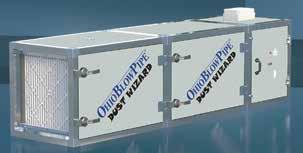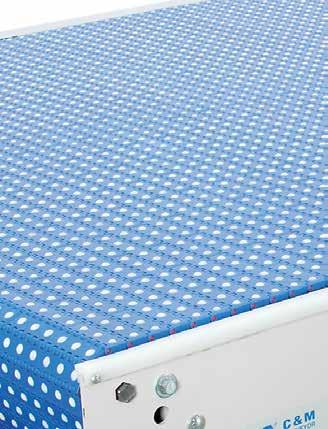
4 minute read
Other Uses of Containerboard
from May/June 2020 BoxScore: VR and AR Technologies Hold Untapped Potential for Boxmakers and Clients
BY DICK STORAT
In this article, we will discuss domestic uses of containerboard other than that corrugated by America’s boxmakers. For orientation, the graphic at top right displays graphically the flows of containerboard for the month of February 2020. While the specific numbers will of course change from month to month, the overall pattern remains pretty much the same.
Advertisement
The left side of the graphic shows mill production, which in February amounted to just over 3 million tons. Of the total production, some may go to inventory at mills, which amounted to 29,000 tons in February. A substantial fraction of production is made for export and shown as an outflow of 462,000 tons in the diagram. In February, that amounted to 15% of the total U.S. production, mainly unbleached kraft linerboard grades, some 20% of which is exported monthly.
Imports, mostly from Canada, account for about 4%–5% of monthly consumption. Also, containerboard held in inventory at box plants can contribute to corrugated volume. In February, 48,000 tons of box plant inventory contributed 1.9% of the 2.517 million tons consumed by corrugators during the month. The remaining 2.356 million tons of February’s corrugated volume was supplied by domestic containerboard mills, amounting to 93.6% of February’s consumption and 78% of production.
On top of containerboard that is converted in the U.S., there are uses of containerboard that do not involve corrugation. These are not reported but imputed as the remainder of board produced by mills after adjustment for inventory change and trade flows. It is labeled as “Other Uses” in the top graphic.
UID
400 Unidentified Uses of Containerboard
250 300 350
Three-year average = 150,000 tons/month
200
0 50 100 150 (000 Tons)
-50
-100
-150 JAN FEB MAR APR MAY JUN JUL AUG SEP OCT NOV DEC 2018 2019 2020 Source: AF&PA, FBA, RSA
In February, these other uses amounted to 162,000 tons, or 5.4% of monthly containerboard production. These can be considered in several distinct categories.
The first and largest category is actual uses of linerboard or medium. The full spectrum of uses for which linerboard and medium are needed is broad, if not accounted for in statistical reports. Over time, these other uses amount to about 150,000 tons per month, and they track with what some industry observers believe the actual other uses to be.
While these other uses have remained fairly constant over multiyear periods, the monthly swings can be quite volatile, Page 1
as the bottom chart shows. It plots the monthly imputed other uses of containerboard for the past 26 months ending in February 2020.
The bold line indicating 150,000 tons per year is the monthly other uses averaged over the past three years. This averaging eliminates the wide monthly swings. While some of the remaining variability is part of normal swings in short-term demand for containerboard to be used without corrugation, other factors are involved.
Monthly inventory statistics supplied by mills and box plants do not include containerboard that is in transit on rail cars or trucks between the mills and box plants. If the volume in transit does not change significantly, there will be no effect on other uses. However, if the amount of board in transit rises or falls compared to the prior month, that change in in-transit containerboard will be accounted for as an additional use or source of containerboard.
Changes from the amount of containerboard initially reported by mills as being made for export will also impact the amount of other uses. If an amount of mill production is reported as made for export but is subsequently diverted to domestic usage at box plants, it will also show up as additional corrugator production and a reduction to other uses.
Sometimes, inventories are more completely counted at the end of a fiscal quarter or year. When that additional inventory “reenters the statistical reporting system,” it will show up as a reduction of other uses. If the more exhaustive counting of inventory yields a sufficient increase of mill or containerboard stocks, the imputed other uses of containerboard can become negative, providing another source of containerboard for corrugators.
Understanding the behavior of the imputed other uses of containerboard can be helpful in assessing the relative market balance between supply and demand. For example, evaluating one month’s rise in other uses as future additional rollstock likely to show up in the box plants’ reporting would lead to an assessment that there is more unconverted containerboard supply than may be assessed from the mill and box plant inventory levels alone.
Dick Storat is president of Richard Storat & Associates. He can be reached at 610-282-6033 or storatre@aol.com.
ROLLERLESS SURFACE ROLLERLESS SURFACE

WIN THE WAR ON DUST
Our mesh ball bundle conveyor is a must for load-forming operations, allowing transfer rates of 20+ bundles per minute. Call today; let us solve your toughest problem.


Leading supplier to the corrugated box industry

812-558-7960 • sales@cmconveyor.com www.cmconveyor.com
The Dust Wizard is an ambient air dust cleaner for the removal of dust contamination where direct source capture is difficult, such as converting equipment, baler or shredder. Creates a healthier, more productive work environment with clean air.
MORE THAN AIR SYSTEMS 216.681.7379 • sales@obpairsystems.com www.obpairsystems.com/dust-wizard/









